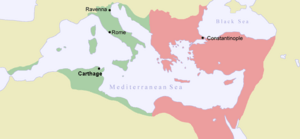Plague of Justinian facts for kids

The Plague of Justinian was a terrible sickness that spread across the Byzantine Empire from 541 to 542. It was the first time a major plague pandemic was written about in history. Experts believe this plague, which kept returning about every twelve years until 770, might have killed as many as 100 million people worldwide.
This plague caused the population of Europe to drop by about half between 541 and 700. It might have also helped the Muslim conquests succeed later on. Its huge impact on society and culture was similar to that of the Black Death much later.
Where Did the Plague Come From?
The plague likely started in places like Ethiopia or Egypt. It then traveled north to the large city of Constantinople. Ships that brought grain to the city often carried many rats. These rats were infected with the plague and helped it spread.
At its worst, the plague killed 10,000 people in Constantinople every single day. It eventually wiped out 40% of the city's population. Overall, about 25 million people died because of this plague. Some historians believe it weakened the Byzantine Empire. This was because it killed many farmers, leading to food shortages. The empire also lost a lot of tax money when so many people died.
Images for kids
-
This is a basilica (a type of large building) in Philippi that was never finished. Many believe its construction stopped because of the Plague of Justinian.
See also
 In Spanish: Plaga de Justiniano para niños
In Spanish: Plaga de Justiniano para niños


